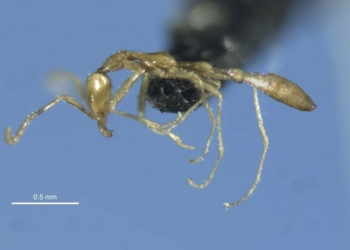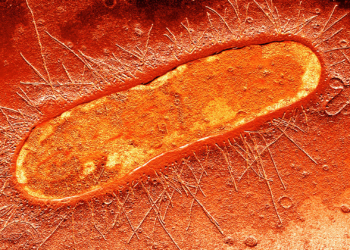A previously unknown species of elephant bird was recently discovered on the northeastern side of Madagascar and was identified solely from its ancient eggshells
© Copyright by GrrlScientist | hosted by Forbes
Surface scatter of Aepyornis eggshell exposed by active wind erosion of sand dunes where the birds … [+]
More than 1200 years ago, the island of Madagascar was home to an amazing collection of flightless ostrich-like birds standing more than three meters (9-10 feet) tall, weighing around 2200 pounds and laying eggs that were larger than a football. These magnificent giants were known as elephant birds. Today, all that’s left of these birds are a few scattered bones and eggshell fragments — and a lot of unanswered questions. Questions like: How many species were there? What did these giant birds eat? Do they have any living relatives?
An international team of researchers published a new study (ref) recently, announcing their discovery of yet another, distinct lineage of elephant bird. But surprisingly, this remarkable discovery was not the result of finding a skeleton, or even a few bones: it was based solely on DNA extracted from some scattered eggshell fragments that the scientists had spent years collecting on the northeastern part of the island.
“This is the first time a taxonomic identification has been derived from an elephant bird eggshell and it opens up a field that nobody would have thought about before”, said study co-author, geologist Gifford Miller, distinguished professor of geological sciences and faculty fellow at the Institute of Arctic and Alpine Research at the University of Colorado at Boulder. One of Professor Miller’s several areas of expertise is the study of ancient eggshells in Australia and around the world.
“Here may be another way of looking into the past and asking, ‘Was there more diversity in birds than we’re aware of?’” Professor Miller pondered.
This pioneering discovery is important because bird bones are delicate and usually do not last long. Identifying a new bird species from its ancient eggshell fragments may allow scientists to learn more about the diversity of birds that once roamed the planet.
F I G U R E 1 | a Map of Madagascar depicting the geographic location of eggshell samples collected … [+]
Elephant birds are a product of their unique island environment and its geological history. Madagascar is a large island that split away from the Indian subcontinent around 90 million years ago, and from Africa at least 60 million years ago. Ever since these events, Madagascar has remained separated from all continental landmasses by deep oceanic waters. This lengthy isolation allowed plants and animals to follow their own evolutionary pathways so that almost all of the island’s biodiversity is singular, and found nowhere else on the planet.
Then people arrived. Madagascar was originally colonized by Austronesian peoples, who probably floated in from Indonesia around 2,000 years ago, followed later by the Bantu from East Africa and others. When these peoples arrived, they were likely terrified by Madagascar’s largest land animal: Aepyornis, or vorompatra in the Malagasy language, a towering bird weighing as much as a rhinoceros and equipped with a pointy beak and deadly no-nonsense talons. Similar to Africa’s ostrich, South America’s rhea, Australia’s emu and cassowary, and New Zealand’s moa and kiwi, Madagascar’s elephant birds were flightless. And yet, elephant birds were so impressive that they may have inspired myths of the roc, or Rukh, a gigantic flighted bird with a reputation for carrying off elephants and other large animals to eat.
An elephant bird egg (Aepyornis maximus) reconstructed from fragments in a Toliara (south-west … [+]
Lead author of the recent study, Alicia Grealy, now based at CSIRO, conducted this research as part of her doctoral thesis at Curtin University. To do this research, she and her collaborators collected more than 960 eggshell fragments from 291 localities across the southern, central, and, for the first time ever, northern Madagascar (Figure 1a). Radiocarbon dates indicate that the collected eggshells were between 1290 and 6190 years old, and they are contemporaneous with most previously radiocarbon dated bone specimens from these areas.
Measurements of the thicknesses of eggshell fragments revealed three distinct morphotypes: in the dry southern portion of the island, two separate eggshell thicknesses were measured (Figure 1b). Eggshells collected in the swampy, forested northern parts of Madagascar had an intermediate thickness between the two southern eggshell morphotypes.
Extrapolating from measured eggshell thicknesses and the corresponding masses of the bird species that produced them, the team estimated that the mass of elephant birds producing the thinnest eggshells would have been emu-sized birds with a mass of approximately 41 kg (90 lbs), whereas the thickest eggshells would have been laid by birds weighing approximately 1000 kg (2205 lbs). Building upon these same methods, the eggshells with intermediate thickness were probably laid by intermediate-sized birds that the team estimated to weigh around 230 kg (507 lbs).
Dr Grealy then extracted ancient DNA (aDNA) and protein molecules from eggshells from each morphotype and retrieved three elephant bird mitochondrial genomes. Dr Grealy found that the ancient mitochondrial DNA was so well sealed into the eggshells that she estimated it probably could survive relatively intact for 10,000 years.
After analyzing the aDNA and protein sequences from the ancient eggshells, Dr Grealy and her collaborators concluded that the elephant bird family tree, which originally was thought to comprise 16 species, actually encompassed just three sexually dimorphic species, where females were about twice as big as the males. They also confirmed a previous discovery that elephant birds are most closely related to the flightless chicken-sized kiwi bird – a finding that has changed our view of avian evolution.
A North Island Brown Kiwi (Apteryx mantelli) at Rainbow Springs in Rotorua, North Island, New … [+]
Dr Grealy and her collaborators’ efforts created a new collection of elephant bird eggshells that are found in Madagascar’s far north, which they determined were genetically distinct from other elephant bird eggshells. Thus, they concluded that these northern eggshells represent a novel species of Aepyornis elephant bird, whose skeletal fossils still await discovery pending a concerted search.
“Molecules preserved in some of these eggshells helped us discover a potentially new species which lived in the top end of the country”, Dr Grealy stated.
The researchers concluded that elephant birds were, despite their terrifying sizes, vegetarians.
“We were also able to determine that different species ate a mixture of grass, shrubs and succulents”, Dr Grealy elaborated.
Finally, Dr Grealy and her team discovered that extreme gigantism was a relatively recent evolutionary development in elephant birds — and was probably due to the changing climate that drove the expansion of grasslands during the Pleistocene.
“Another surprising finding is that the gigantic size of the largest elephant birds (Aepyornis maximus) likely arose within the last 1.4 million years, alongside the changing environment and ecosystem in Madagascar”, Dr Grealy asserted. “This species nearly doubled in size over a very rapid and recent time frame.”
“It is amazing to think that these thousand-year-old egg fragments can give us insight as to where elephant birds lived, what they ate, how their ancestors might have looked, and how they evolved over the years,” Dr Grealy commented.
“The findings contribute to our understanding of how elephant birds lived and functioned within Madagascar’s unique ecosystems, and also reinforces how ancient DNA from eggshells is a promising avenue for studying the evolution and extinction of giant animals,” Dr Grealy explained.
“There’s surprisingly a lot to discover from egg shell.”
Source:
Alicia Grealy, Gifford H. Miller, Matthew J. Phillips, Simon J. Clarke, Marilyn Fogel, Diana Patalwala, Paul Rigby, Alysia Hubbard, Beatrice Demarchi, Matthew Collins, Meaghan Mackie, Jorune Sakalauskaite, Josefin Stiller, Julia A. Clarke, Lucas J. Legendre, Kristina Douglass, James Hansford, James Haile & Michael Bunce (2023). Molecular exploration of fossil eggshell uncovers hidden lineage of giant extinct bird, Nature Communications 14:914 | doi:10.1038/s41467-023-36405-3
SHA-256: 9ab94921e06b203a216cb219d873f92ea4083642075e2e0be632939cd42949aa
Socials: Mastodon | Spoutible | CounterSocial | MeWe | Post.News | Newsletter













